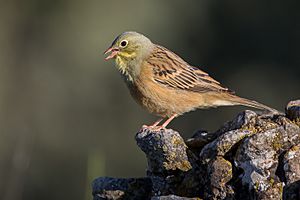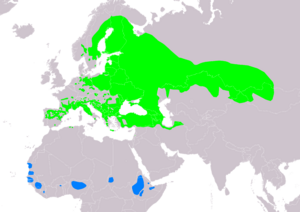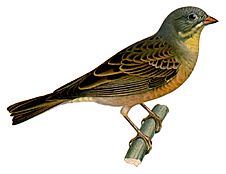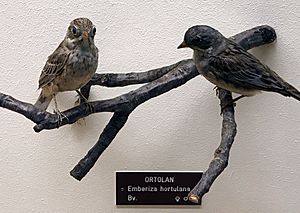Ortolan bunting facts for kids
Quick facts for kids Ortolan bunting |
|
|---|---|
 |
|
| Conservation status | |
| Scientific classification | |
 |
|
| Range of E. hortulana Breeding Non-breeding |
The ortolan (Emberiza hortulana), also known as the ortolan bunting, is a small bird found in Europe and western Asia. It belongs to the bunting family, Emberizidae. This family is different from the finches.
The name Emberiza comes from an old German word for a bunting. The word hortulana comes from the Italian name for this bird, which is ortolana. In English, "ortolan" comes from a French word meaning "gardener."
The ortolan has been a special dish in French cuisine for a long time. People usually cook and eat the whole bird. Traditionally, diners would cover their heads with a napkin or towel while eating this delicacy. Because the bird was eaten so much, its numbers in France dropped very low. This led to laws being made in 1999 to protect it. In 2007, the French government promised to enforce these laws more strictly.
Contents
About the Ortolan Bunting
Where the Ortolan Got Its Name
The ortolan bunting was first described by a Swedish scientist named Carl Linnaeus in 1758. He gave it the scientific name Emberiza hortulana, which it still has today. This bird is the only one of its kind (monotypic). Scientists have studied the DNA of buntings. They found that the ortolan bunting is most closely related to Cretzschmar's bunting.
What the Ortolan Looks Like
The ortolan bunting is about 16 to 17 centimeters (about 6.3 to 6.7 inches) long. Its wingspan is about 23 to 29 centimeters (about 9 to 11.4 inches). It looks a lot like its relative, the yellowhammer. However, the ortolan is not as brightly colored. For example, its head is a greenish-gray, not bright yellow. The male ortolan's song sounds similar to the yellowhammer's song.
Where Ortolans Live and Their Habitat
The ortolan is found in most European countries and western Asia. It lives as far north as Scandinavia, even beyond the Arctic Circle. These birds often live in cornfields and nearby areas. It is rare to see them in the British Isles, especially in autumn.
In November 2018, an ortolan was seen and photographed in Kenjar Coastal Karnataka, India. Birdwatchers believe this was the first time an ortolan bunting was photographed in India.
Ortolan Behaviour and Life Cycle
Ortolan nests are usually built on or very close to the ground.
The oldest ortolan ever recorded lived for six years and ten months. This bird was found in Switzerland.
Ortolans naturally eat seeds. However, when they are feeding their young, they also eat beetles and other insects.
The Ortolan as a Traditional Food
For a long time, ortolans were caught and eaten as a special dish. The birds were caught using nets during their autumn migration to Africa. After being caught, they were kept in dark cages or boxes. In the dark, the birds would eat a lot of grain, usually millet seeds. They would eat so much that they would double their size. Then, the birds were prepared in a special way, often with a type of brandy called Armagnac.
The bird was then roasted for about eight minutes and its feathers were removed. People would traditionally eat the whole bird, sometimes without the head. They would put the bird feet-first into their mouth. They would then spit out the larger bones.
A very old tradition for eating ortolans was for French gourmands (people who love food) to cover their heads and faces with a large napkin or towel. People debate why they did this. Some say it was to keep the smell and flavor of the bird close as they ate it. Others suggest it was part of a special ritual. This tradition was started by a priest, who was a friend of a famous food writer named Jean Anthelme Brillat-Savarin.
Long ago, the island of Cyprus was a major place for exporting ortolans. They were preserved in spices and vinegar and packed into large barrels. Each barrel held about 300 to 400 birds. In the early 1900s, Cyprus exported hundreds of these barrels every year.
Famous Meals with Ortolans
- At the Three Emperors Dinner in 1867, ortolans on toast were one of 16 courses served.
- In 1995, former French President François Mitterrand had this specially prepared bird for his last New Year's Eve meal.
Protecting the Ortolan Bunting
Legal Status and Conservation
Hunting ortolans was banned in France in 1999. However, this law was not always followed well. It is believed that up to 50,000 ortolans were illegally killed each year during their autumn migration. Most of these birds came from places like Finland and the Baltic area.
According to France's League for the Protection of Birds, the number of ortolans in France dropped by 30% between 1997 and 2007. In 2007, the French government promised to strictly enforce the rules against hunting them. The biggest fine for breaking these rules was set at €6,000 (about $6,728).
Killing and cooking ortolans is now banned across the entire European Union. In 2007, groups like France's League for Protection of Birds and the European Union put pressure on the French government. This led the government to promise to follow the EU rules that protect the ortolan. Even after several years, people continued to watch and found that not much had changed. So, in 2016, the local government representative repeated the promise to enforce the rules.
Countries in the European Union are not allowed to:
- Deliberately kill or catch these birds using any method.
- Deliberately destroy or damage their nests and eggs, or remove their nests.
- Take their eggs from the wild and keep them.
- Deliberately bother these birds, especially when they are breeding and raising their young. This is to make sure it does not harm the birds.
- Keep birds that are not allowed to be hunted or caught.
- Sell, transport for sale, keep for sale, or offer for sale live or dead birds. This also includes any parts or products made from these birds.
As of 2018, the total population of the ortolan bunting is listed by the IUCN as "Least Concern" (LC). This means that while there were concerns, the species is not currently at high risk of extinction.
See also
 In Spanish: Escribano hortelano para niños
In Spanish: Escribano hortelano para niños





